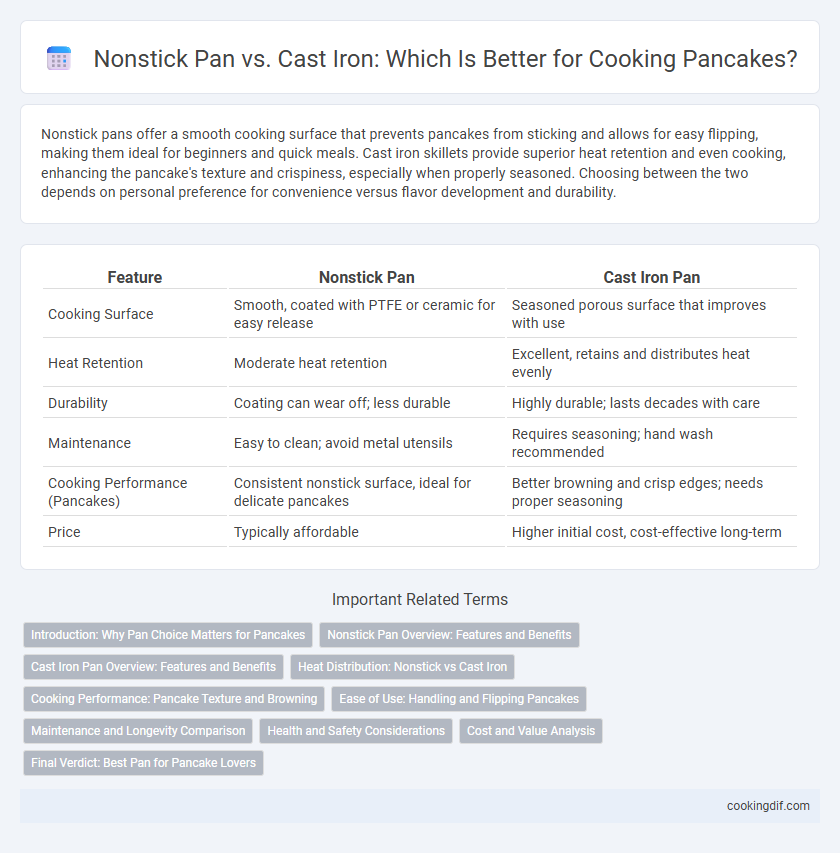Nonstick pans offer a smooth cooking surface that prevents pancakes from sticking and allows for easy flipping, making them ideal for beginners and quick meals. Cast iron skillets provide superior heat retention and even cooking, enhancing the pancake's texture and crispiness, especially when properly seasoned. Choosing between the two depends on personal preference for convenience versus flavor development and durability.
Table of Comparison
| Feature | Nonstick Pan | Cast Iron Pan |
|---|---|---|
| Cooking Surface | Smooth, coated with PTFE or ceramic for easy release | Seasoned porous surface that improves with use |
| Heat Retention | Moderate heat retention | Excellent, retains and distributes heat evenly |
| Durability | Coating can wear off; less durable | Highly durable; lasts decades with care |
| Maintenance | Easy to clean; avoid metal utensils | Requires seasoning; hand wash recommended |
| Cooking Performance (Pancakes) | Consistent nonstick surface, ideal for delicate pancakes | Better browning and crisp edges; needs proper seasoning |
| Price | Typically affordable | Higher initial cost, cost-effective long-term |
Introduction: Why Pan Choice Matters for Pancakes
Choosing the right pan significantly impacts pancake texture and cooking efficiency. Nonstick pans offer even heat distribution and easy release, preventing sticking and promoting uniform browning. Cast iron pans retain heat longer and add a distinct flavor but require proper seasoning to maintain their nonstick properties.
Nonstick Pan Overview: Features and Benefits
Nonstick pans offer a smooth cooking surface that ensures pancakes cook evenly without sticking, reducing the need for excess oil or butter. Their quick and easy cleanup process is ideal for frequent pancake preparation, while the lightweight design enhances maneuverability during flipping. These pans typically feature a durable nonstick coating that maintains performance over time, making them a practical choice for both novice and experienced cooks.
Cast Iron Pan Overview: Features and Benefits
Cast iron pans offer superior heat retention and even cooking surfaces, which are essential for achieving perfectly golden pancakes with a consistent texture. Their natural seasoning creates a nonstick layer that improves over time, reducing the need for added fats and preventing sticking. Durable and versatile, cast iron pans can withstand high temperatures and are suitable for stovetop, oven, and outdoor cooking, making them a long-lasting investment for pancake enthusiasts.
Heat Distribution: Nonstick vs Cast Iron
Cast iron pans excel in heat distribution due to their thick, dense material, providing even cooking and consistent browning for pancakes. Nonstick pans heat up quickly but often feature thinner bases that can cause hot spots, leading to uneven cooking surfaces. Opt for cast iron when uniform heat is crucial for perfect pancake texture and golden color.
Cooking Performance: Pancake Texture and Browning
Nonstick pans provide even heat distribution that ensures pancakes have a uniformly golden-brown surface with a soft, tender texture. Cast iron skillets offer superior heat retention, producing a crispy edge and deeper browning that enhances flavor complexity. For achieving the ideal pancake texture and consistent browning, nonstick pans excel in ease of use, while cast iron delivers richer caramelization and a rustic finish.
Ease of Use: Handling and Flipping Pancakes
Nonstick pans offer superior ease of use when handling and flipping pancakes due to their smooth surface that prevents sticking and requires less oil or butter. Cast iron pans, while excellent for heat retention, demand more careful seasoning and higher maintenance to maintain a nonstick surface, which can complicate flipping pancakes without tearing. For quick and hassle-free pancake cooking, nonstick pans provide more consistent results and user-friendly handling.
Maintenance and Longevity Comparison
Nonstick pans require minimal maintenance but often have a shorter lifespan due to coating degradation from high heat and metal utensils. Cast iron demands regular seasoning and thorough drying to prevent rust, yet offers unmatched durability that can last generations with proper care. Choosing between the two depends on balancing the ease of upkeep with long-term longevity for consistent pancake cooking performance.
Health and Safety Considerations
Nonstick pans typically contain coatings like PTFE that can release toxic fumes if overheated above 500degF, posing health risks. Cast iron pans naturally provide a chemical-free cooking surface and can increase dietary iron intake, beneficial for health. However, cast iron requires regular seasoning to maintain its nonstick properties and prevent rust, ensuring food safety.
Cost and Value Analysis
Nonstick pans typically offer a lower initial cost and ease of use, making them ideal for budget-conscious cooks seeking convenience in pancake preparation. Cast iron pans, though requiring a higher upfront investment, provide exceptional durability and heat retention, delivering long-term value through consistent, evenly cooked pancakes and minimal replacement costs. Evaluating cookware cost-effectiveness involves balancing nonstick affordability with cast iron's superior lifespan and performance.
Final Verdict: Best Pan for Pancake Lovers
Nonstick pans excel in delivering evenly cooked, fluffy pancakes with minimal oil and effortless flipping, making them ideal for quick and convenient breakfast preparation. Cast iron skillets offer superior heat retention and develop a natural seasoning that enhances pancake flavor and texture over time, favored by enthusiasts seeking durability and a rustic cooking experience. For pancake lovers prioritizing ease and consistent results, nonstick pans are the best choice, while cast iron is preferred by those valuing long-term seasoning and versatility.
Nonstick pan vs cast iron for cooking surface Infographic

 cookingdif.com
cookingdif.com